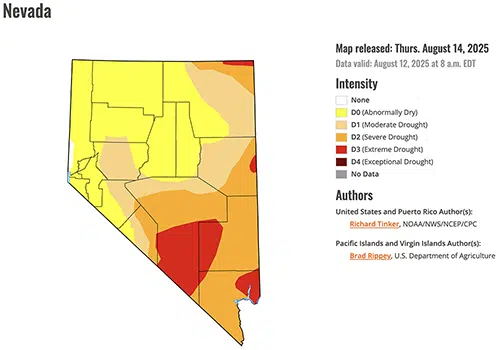FOR IMMEDIATE RELEASE
Tuesday, August 19, 2025
Contact:
Chandra Rosenthal, [email protected], 303-898-0798
Nevada in Drought, BLM Silent
Advocates Request Land Managers Activate Drought Protections as Extreme Conditions Grip Rangelands
Elko, NV — As Nevada experiences severe drought, conservation advocates are raising alarms over the Bureau of Land Management’s (BLM) apparent inaction on public lands. Despite extreme conditions in counties such as Elko, Lincoln, and White Pine, BLM has not issued any public notice implementing its drought response protocol, outlined in Instruction Memorandum 2013-094, titled “Resource Management During Drought.”
 According to the latest NOAA Drought Monitor (August 18, 2025), vast swaths of Nevada remain in “Extreme Drought.” This level of drought triggers a range of agency actions under the 2013 Drought IM—measures specifically designed to prevent long-term damage to rangelands, native vegetation, wildlife, and water sources.
According to the latest NOAA Drought Monitor (August 18, 2025), vast swaths of Nevada remain in “Extreme Drought.” This level of drought triggers a range of agency actions under the 2013 Drought IM—measures specifically designed to prevent long-term damage to rangelands, native vegetation, wildlife, and water sources.
“In past years, BLM responded to similar drought conditions with transparency and action,” said Chandra Rosenthal, Public Lands Advocate at Public Employees for Environmental Responsibility “This time, we’re hearing nothing—not even a signal that monitoring has increased or that livestock use is being adjusted. That silence is deeply troubling.”
The 2013 Drought IM directs field offices to assess drought-stressed resources and coordinate with permittees to mitigate impacts. Recommended actions include reducing authorized grazing (AUMs), delaying livestock turnout, hauling water for wild horses and wildlife, and closing drought-impacted areas to minimize degradation. However, there has been no indication that these measures are currently in place.
“We’ve reached out to the Nevada State Director for clarification but have received no response,” said Chandra. “There is a protocol. There is a map. The time is now.”
The group points to PEER’s “Mapping the Range” project (peer.org/mapping-the-range), which visualizes land health assessments and underscores the widespread stress facing public rangelands, even in non-drought years.
Unrestricted grazing during drought depletes already stressed vegetation, leading to long-term loss of native plant cover and increased soil erosion. Without sufficient recovery time, rangelands may fail to regenerate even after fall rains, leaving bare ground vulnerable to invasive species like cheatgrass. Degraded conditions can persist into the fall and beyond, compromising forage for wildlife and livestock and reducing the land’s overall resilience.
PEER is urging BLM Nevada to publicly disclose its drought response strategy and to convene a meeting with stakeholders, including conservation groups, local communities, and permittees, to ensure transparent, science-based land management.
###
See the US Drought Monitor map
Read PEERs letter to BLM State Director John Raby
Review BLM’s land health data mapped by PEER
PEER protects public employees who protect our environment. We are a service organization for environmental and public health professionals, land managers, scientists, enforcement officers and other civil servants dedicated to upholding environmental laws and values. We work with current and former federal, state, local and tribal employees.